How To Use Anchor Text To Get Noticed By Google (And Bring In More Leads)

Anchor text. You know, the underlined words that make up a text link.
Maybe you think you’re doing everything you can to use it effectively.
I know I used to think so—I’d insert links in my articles here and there, within a sentence where I thought it made sense.
I’ve linked to a generic “click here” or “for more information.” I’ve used brand names as anchor text to key landing pages because I wasn’t sure what else to link to.
I’ve even tried to link with text that was an exact keyword on my website. Or entire sentences, or with just one word.
While some of these practices are OK, some of them are way wrong when it comes to ranking well with search engines.
- In one case you could be bleeding traffic, or SEO “Google Juice”
- In another, you’re missing opportunities to get your key landing landings to rank high in search research (or even earn a higher click rate on your site!)
For best results, you need to understand current best practices before you dive into using anchor text on your website or within your articles or blog posts.
Once you know the best practices and how it works to help or hurt your traffic, inserting quality links that grow your search ranking, clicks, and leads will become second nature.
There’s a lot you can do with anchor text when writing online content. And anchor text can do a lot more for your SEO performance than you think.
In fact, using anchor text effectively is pretty much a requirement these days for your search ranking and credibility with search engines.
What follows is a detailed look at what anchor text is, the best practices in the industry, and an in-depth overview of how to use it in your SEO strategy.
After reading this, you’ll understand exactly what you need to do to use anchor text to your advantage. And to stay on Google’s good side.
Let’s dive in.
What Is Anchor Text?
Let’s start with the basics.
Anchor text is the text on which you place your links in a sentence. For example, I’m linking these words to our homepage. That linked text is your anchor text.
The linked text is usually in another color on webpages or online articles, and is underlined. This is to show the reader that by clicking, they’ll be redirected to another page.
Because readers will be redirected to that other page, it’s important to insert the link to the text that does the most work in the sentence. In other words, the meat of the sentence.
Below is an example of anchor text, with a brief explanation, from Moz.
Here’s an example of what the HTML code looks like when you insert a link under anchor text:

A lot of online content may use generic anchor text, especially before anchor text was really figured out. Often, online writers would insert links in the following way:
“Click here for more information.”
The “here” or the “click here” would be clickable and would send the reader to another webpage. Some content still implements this kind of anchor text.
This is not really an SEO best practice in online writing. For SEO results, linking to “here” will do absolutely nothing for you. It doesn’t tell your reader, or Google, anything about where that link will take you.
Read on about other ways you can and should insert the links.
Types of Anchor Text
Now that you understand what anchor text is, let’s cover the different types you can use.
Keep in mind that other companies and content producers are going to be linking to your pages as well, and will be using one of these types of anchor text.
Yoast outlines the following different types of anchor text. I’ve inserted examples using our own website and blog, so you can see how these types differ.
- Branded links or site names. This is when you use the actual name of a company or site name in the anchor text. This is a pretty straightforward option.
Growbo provides advice about sales funnels.
Similarly, linking to the specific site name, which often includes the brand, looks like:
Growbo.com provides advice about sales funnels.</>
- The exact URL, or the “naked link.” This is not a very SEO friendly or helpful option for you. This is when you use the exact URL as text instead of any related words or keywords. An example:
What sales funnel advice? Visit https://www.growbo.com/.
- Article title. This type of anchor text is when you use the title of the page or article you’re linking to as anchor text. Here’s another example:
Check out our newest article, 29 Proven Strategies to Flow Customers through Your Sales Funnel.
- Keyword or phrase. You can use specific SEO keywords or phrases as anchor text that directly relate to the webpage you’re linking to. This can look like:
Growbo provides advice about sales funnels.
While you may think this is getting to more of that meat of your sentence we talked about, you have to be very careful about using exact match keywords.
Exact match keywords can get you into trouble with Google’s algorithm. More on this later.
- Variants of your keyword. This tactic allows you to switch up words in a sentence so that you’re not using the exact same keywords or phrases at each mention. This is much better than using exact match keywords.
Growbo provides advice about generating sales leads through various funnels.
- Related keywords. This is when you use keywords that are related to the main keywords, but are not those exact keywords.
Growbo provides advice about improving your marketing pipeline.
- Generic links. As I mentioned before, generic linking is text like “click here” or “read more here” or the like.
Click here to learn how Growbo helps entrepreneurs succeed.
The below chart shows a few more common examples of generic anchor text.
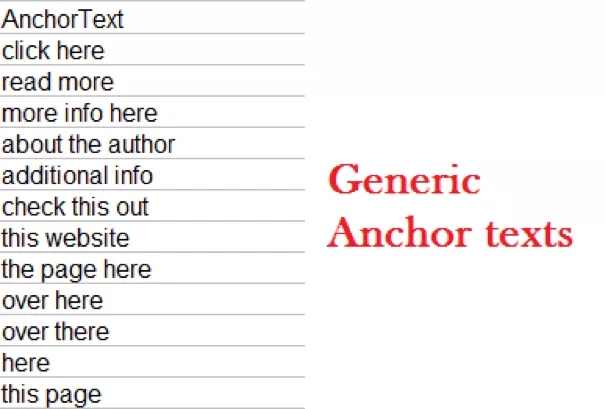
- Long-tail keywords. Technically, an article title or a partial-keyword anchor could be considered a long-tail keyword. These anchors are typically over four words. While these can be really helpful in your rankings because the extra space allows for more descriptive anchor text, make sure you don’t anchor an entire sentence, as Yoast suggests.
Understanding the different forms anchor text can take allows you to see what to do and what to avoid when creating your own.
From this list, you want to avoid: generic anchor text, exact match anchor text, and the URL itself as anchor text.
Creating Value with Your Anchor Text: Finding the Meat

Now that you’ve seen the different types of anchor text, let’s talk about how both you and your readers can get the most value from it.
First of all, use common sense to figure out which words are doing the most work in a sentence. Which words are most valuable? Which words best describe the page you’re linking to?
This sounds easy, and it will become simpler for you, I promise. Let’s practice with the below sentence.
If you want to improve your sales performance, it’s important to understand the different levels of the sales funnel.
Now, which part of this sentence is the meat? Think about which words are doing the work, providing important information.
Which words are most helpful to a reader that wants to learn about sales funnels?
What if I linked as follows:
If you want to improve your sales performance, it’s important to understand the different levels of the sales funnel.
Here, I’ve linked “it’s important to understand.” This may seem like it’s doing some work for the sentence--it’s fairly active and tells the reader they need to learn something.
But what is important to understand? This text alone doesn’t really say anything. For all the reader knows, clicking that link could take them to a definition of “understand.” It’s just way too vague.
Similarly, take a look at the below example.
If you want to improve your sales performance, it’s important to understand the different levels of the sales funnel.
The underlined text may be valuable to readers, right? They do want to improve. Something. But what?
Again, this text left on its own is too vague and not really helpful. It can take them anywhere that’s related to improving.
Now, let’s talk about the real meat.
There are two pretty good places in this sentence to insert your link, depending on the content you’re redirecting to. Sometimes, anchor text can work well in more than one place.
See if you can figure out these two better places before reading on.
OK. Here’s the first good example.
If you want to improve your sales performance, it’s important to understand the different levels of the sales funnel.
I’ve underlined “improve your sales performance.” Why?
Because that’s interesting to readers. They are reading your content because they want to improve their sales, right? That makes the link under this anchor text extremely valuable to them.
The appropriate content to link to would be something related to improving sales performance, either on your own website or a third-party authority on the matter.
Now let’s look at the even better option here.
If you want to improve your sales performance, it’s important to understand the different levels of the sales funnel.
Why is this better? Because it’s getting into specifics. Using this anchor text, you can link back to a page that explains the different levels of a sales funnel. Like the one I just linked to.
This is the meatiest part of the sentence. The reader will know exactly what they’re clicking. And taking them to a page with a graph of the different sales funnel levels will immediately show them what you’re talking about.
Make sense?
This kind of attention to your anchor text will also show Google that you’re using keywords to link to valuable information related to those keywords. Being specific shows search engines what your content is about, and what the linked content is about.
Remember that meat can also come from a brand or website name. Branded anchor text, where you link a website to its brand name, is another pretty safe linking tactic. In fact, some sources, like SEMrush, say that 40% of anchor text can be branded.
Remember to: Think meat. Think specifics. And think like your reader.
What is the most valuable information in a given sentence?
How Anchor Text Works with SEO
When it comes to SEO, Google still sets the rules. And they account for over 90% of online searches.
Anyone trying to rank in the SERP (search engine results page) must conform to their latest practices.
What’s a SERP and Why Should I Care?
Below is an example of a basic SERP.
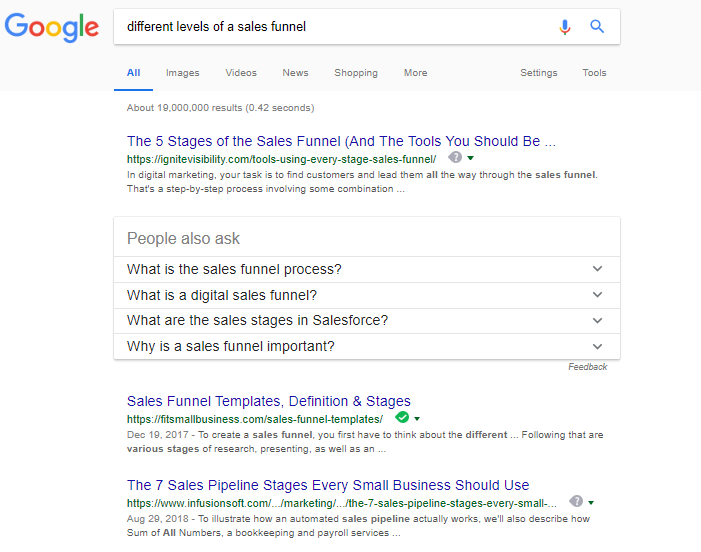
So how does Google recognize SEO and anchor text, as its advanced algorithms mine through loads and loads of online content?
First, good anchor text adds to the dynamic weight of the page it leads to, as Sitechecker points out. The better the anchor text is, the more significant information can be gotten from that text. Therefore, it has more weight.
So, using our previous example, since “different levels of a sales funnel” directly describes the page a reader is redirected to, Google’s searching bots will tick that as a win for the anchor text.
This wording is much more helpful to Google that just “sales funnel.” It’s much more descriptive and therefore genuine.
The page you’re linking to is being described by certain keywords and terms, and it helps Google understand what the page or website is about.
What about Linking Associations?
Hopefully as your brand continues to build, and your content outreach expands, reputable sites will start linking to your pages in their own content. The anchor text terms they use can help your SERP location.
Google likes to see it both ways—you using accurate and explanatory anchor text to link to third parties, and authoritative websites linking back to you with the same.
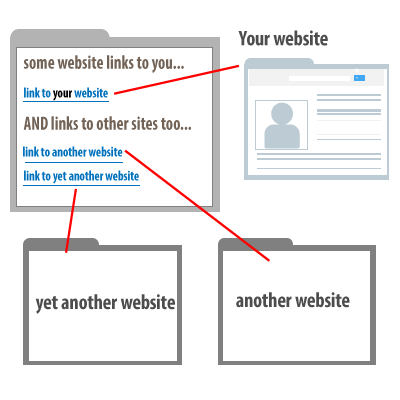
If one third-party article links to your site, as well as other reputable sites within the same article, Google understands that all of you may be authorities in a given industry or on a given subject.
The more authoritative sites you’re associated with, the better.
Remember that Google looks for high-quality links. This means that readers are given an accurate description of what a link will redirect them to, and the links go to reputable websites.
So, the more clear and detailed you can be in your anchor text, the better. It helps everyone involved.
This is how both your site and your readers (and really, the pages you’re linking to) can all benefit from high-value anchor text.
And you’ll eventually end up on that first search results page when people search for keywords related to your business.
How Do I Stay on Google’s Good Side with Anchor Text?
Google updates its ranking algorithms (also known as its PageRank system) a lot. Or at least it has since the company was first founded in 1998.
Anchor text used to be a huge factor in the way Google’s crawlers indexed and ranked.
When the company released its Penguin algorithm in 2012, the importance of anchor text changed from being an easy way for Google to understand what a page or article was about, to being one of the most effective ways that Google determines credibility.
Basically, anchor text is still a major factor in their rankings, but for different reasons.
This is also when Google started to track whether a site was over-optimizing, thus allowing them to track genuine links versus spammed links.
The Penguin algorithm has been updated several times since then. It’s important to keep up with these changes to how Google crawls and indexes so you can adapt your SEO strategy accordingly.
What Is Penguin and How Does It Work (And Still Matter)?
The Penguin algorithm was a game changer for link building. Google implemented this tool in 2012 to target websites that were linking to spam or low-quality sites just to manipulate their ranking.
Anchor text was, and still is, one of the biggest factors in these assessments.

When you build a backlink, the Penguin algorithm then indexes that backlink and creates a link profile for your specific website in its database. Google continues to index and record in your link profile as you continue to add links.
The tool can then analyze your link profile as it analyzes your use of keywords on your website. If your links are only using a term that’s an exact match to a keyword optimized in your website content, Google doesn’t like it. You’ll get penalized.
Why? Because it’s easy for the tool to see that you’re trying too hard to rank for a keyword with your anchor text.
It’s really unlikely that every link you are building has to do with one specific keyword that is magically optimized on your website.
Consider this example. A credible dog food company would not naturally have all of its backlinks on its website with the anchor text “dog food.” Links to other sites could be related to dog food, and once and a while linking to these keyword can be OK, but every link should be a bit different.
Google will index the links with this anchor text, simultaneously notice that one of the website’s optimized keywords is “dog food,” and thus penalize that website for not using genuine anchor text.
As Gotch SEO says:
"Exact match anchor text + keyword-rich optimization = Penguin penalty."
However, this doesn’t mean that if you have a genuine link with genuine anchor text that happens to include a variation of your keyword, you’ll be penalized. It’s just clear to Google when this is being way overdone.
This is called over-optimizing.
Making sure your links are genuine and creating valuable, descriptive anchor text is the only way to go.
Understanding how Penguin works will help you understand why anchor text is so important for your ranking.
But what’s really crucial? Making sure you stay on Google’s good side.
Google has developed detailed Webmaster Guidelines that anyone looking to rank their content needs to conform to.
Let’s take a look at other tricks Google says not to do as far as linking.
PageRank
First, let’s look at what PageRank is, exactly, and how it works.
PageRank was the very first algorithm used by Google, and it continues to rank pages every day. The tool was supposedly named after Larry Page, one of Google’s founders. (How appropriate.)
PageRank counts the number and the quality of links to a given page. Then, the algorithm can determine and rank how important that website is.
PageRank assumes that websites that are most important are likely to get more links from other websites.
And this is where some people think they can cheat the system—they will do whatever it takes to increase their number of links from other sites, even if they have to pay for them or enter agreements where two sites excessively link back to one another.
Unfortunately for those trying to manipulate the algorithm, Google can now track such schemes and dock your site points for them.
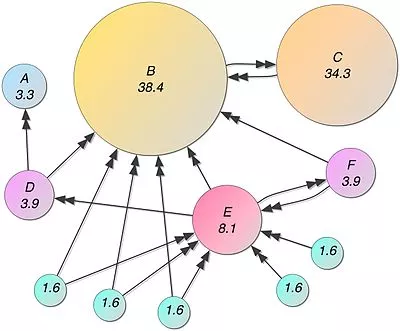
The above image is a representation of how Google uses the algorithm to rank sites with percentages.
Notice that there are more links to E than C, but C is still ranked higher. Even though there are more links to E, those links are not ranked as highly as B, which links to C. Thus, C is ranked higher because a more credible, authoritative site has linked to it.
Let’s look at common manipulations that Google tracks with its most recent algorithm.
Link Schemes
Google doesn’t like to be manipulated. Who would?
With all the scamming and hacking out there today, it’s easy to see why. Google doesn’t want to direct its users to spam or illegitimate sites. Everyone would stop using their search engine if it wasn’t helpful.
An example of how people try to manipulate PageRank is using link schemes. This is when you purposely manipulate outgoing or incoming links that are related to your website, either in an article you post or in someone else’s article that links back to you.
Here’s a list of what Google considers to be link schemes:
- Buying/selling links. If you exchange money or goods and services for links, or even posts that contain links, this is a violation of Google’s Webmaster Guidelines.
- Excessive link exchanges. If you and another website are excessively linking to each other’s website, and the exchanges have no other value than to cross-link, this will end up negatively impacting your site’s ranking.
- Large-scale campaigns. These include article marketing or guest posting campaigns that are only aiming to improve rankings. Google bots can recognize that these posts become excessive and won’t view the keyword-rich anchor text within them positively.
- Automation. If you use automated programs to create links to your site, this is not going to look good to Google. These links are not genuine.
Avoid link schemes altogether if you want to stay on Google’s good side.
Unnatural Links
Similar to link schemes, unnatural links are not genuine and Google therefore does not recognize them as legitimate.
Unnatural links could be:
- Ads that pass PageRank.
- Advertorials or native advertising where a money exchange has taken place for articles that have PageRank-passing links.
- Articles or press releases for distributions on other sites that include optimized anchor text.
- Directory or bookmark site links of low quality.
- Forum comments that include links.
Here’s an example of how links could be unnaturally embedded in a forum comment:

Hidden Text
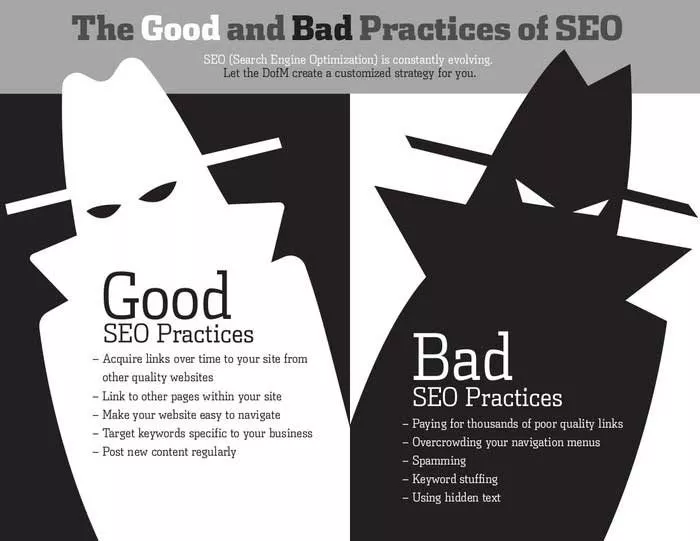
Some sites try to hide links or text to manipulate their search results ranking. This is another violation of Google’s Webmaster guidelines and can get you off the good list quick.
People have been known to make the following manipulations to their online text, according to Google Support:
- Use white text on white background (to hide any text).
- Locate text behind images.
- Set font size to 0.
- Only linking a small character to hide a link (e.g., a hyphen).
If you try these tactics with your anchor text, you can be sure that Google will dock points from your link quality assessment.
Stay on Google’s Good Side
So what can you do to stay on Google’s good side?
Create high-quality content. Link to relevant, credible websites. Don’t try to manipulate the system.
Doesn’t sound too hard, right?
But remember to be patient. You won’t end up on the first SERP overnight. Continue to put out quality content, using SEO best practices and genuine anchor text and linking. And eventually you’ll get there.
Here’s advice straight from Google about high-quality link building:
"The best way to get other sites to create high-quality, relevant links to yours is to create unique, relevant content that can naturally gain popularity in the Internet community. Creating good content pays off: Links are usually editorial votes given by choice, and the more useful content you have, the greater the chances someone else will find that content valuable to their readers and link to it."
Using Anchor Text the Right Way: Key Points
Anchor text can be a very useful tool. You can build credibility for your brand and associate yourself with other authoritative sources.
Just make sure you aren’t trying to manipulate search engines’ algorithms.
Here’s a list of key points, or takeaways, after reviewing all of this detailed information.
Important Takeaways
- Anchor text is the text within a sentence where you insert a link to a third party or to your landing page.
- While there are many types of anchor text, including the generic “click here” text, your best bet is to create anchor text that:
- Is as descriptive as possible.
- Succinctly explains what the redirected page is.
- Is not your exact match keyword.
- Links to a credible, authoritative source.
- Branded anchor text (links underneath a brand name or website name) is pretty safe and could make up quite a large portion of your link building.
- SERP means search engine results page. Ideally you will end up on the first page of a search engine’s results.
- Google uses its Penguin algorithm to ensure that you aren’t trying to over-optimize your links. Try variations of your keyword instead of an exact match. Or, related keywords.
- Google indexes your backlinks and can track if you are using the same keywords in anchor text over and over.
- Make sure you link to the real meat of a sentence. Anchor text should be active. Anchor text should be specific.
- Familiarize yourself with what Google considers to be manipulative to their algorithm. Avoid:
- Link schemes, like buying links or excessive link exchanges.
- Unnatural links, like forum comments.
- Hidden text or links; for example, text with a white or 0 size font.
- Over-optimized anchor text. Don’t include exact match keywords or the same anchor text a lot.
- Authoritative and credible link associations can help you rank higher with Google.
- If a lot of other credible sites are linking to your website, Google likes it. Just remember that fewer credible links are better than many illegitimate links.
With these anchor text tools in hand, you’re ready to start improving your anchor text and getting Google to notice you. In a good way!
As Google says, the best way to rank well and stay on their good side is to put out high-quality content that will naturally find popularity in the online community.
Of course that’s easier said than done, but the main thing to realize is you need to first focus on your message, your products, and your mission. Once you have all of those things in place, you will naturally gain followers and start looking authoritative online.
When it comes to search engines, your hard work pays off. And paying close attention to your anchor text is just one of the many ways you can build your brand’s online credibility.
(Note: While this article focused heavily on Google best practices, other search engines have similar crawling and indexing standards. Following these best practices will likely get you ranked on the other search engines as well.)
We’d love to hear from you about your experiences with linking. What are some of the ways you’ve found anchor text works or doesn’t work on your website? Do you have a best practice on figuring out your anchor text? How does your brand manage Google’s changing guidelines and systems?
If you’re still looking to build your audience and create a successful sales funnel, here at Growbo, lead generation is our speciality.
Want more sales? Download my [thrive_2step id='18964']11-Point Perfect Sales Funnel Checklist[/thrive_2step] or invest in Growbo's Sales Funnel Training.













